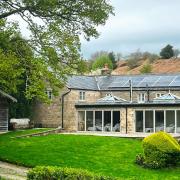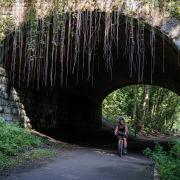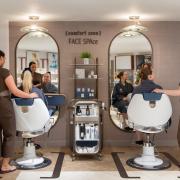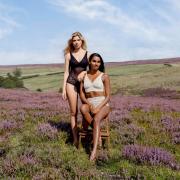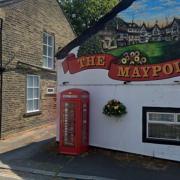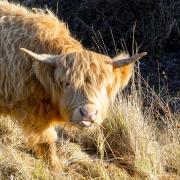In days gone by the fruits of the forest and garden were put to good use making dyes for fabrics. A project in Kirklees is encouraging people to recycle clothes and reduce the impact of fast fashion.
Over the last 70 years the fashion industry has become a global, economic success story. Yet, hidden within its layers of luxury and window dressing are some uncomfortable truths, such as the fact that we buy twice as many clothes as we did in 1980, but now only wear them for half as long. Thankfully, Yorkshire’s Kirklees Council, home of the eponymous 'Made in Huddersfield, England' selvage, is making trail blazing steps to put fashion and textiles back into the heart of its communities, but this time in a naturally, sustainable way.

'Growing Colour Together is one of the biggest projects of WOVEN 2023,' says Elnaz Yazdani, a community artist and educator and a programme manager for the biennial festival which started in 2019. 'Our aim is to not only turn Kirklees into the UK’s largest dye garden, but in doing so celebrate the district’s diverse cultural heritage through community based art, nature and textile projects. It’s also about creating a sustainable legacy for the people of Kirklees.'
With preparations for this year’s festival − running June 3 to July 9 − starting months ago, Elnaz has been busy recruiting teams of artists to lead the project across the district’s three areas of Kirkburton, Birkby and Fartown and Dewsbury. Nationally acclaimed artists have been teamed up with local artists, with each group going on to curate its own distinct programme of horticultural and artistic events.
'In Dewsbury Jane Howroyd, Waheeda Kothdiwala and Natalie Linney have been working with several women’s and girls’ groups,' says Elnaz 'Over the last few months they’ve been teaching the groups how to dye silk using natural dyes made from plants and flowers grown in the community gardens that have been sown and established across the area.

'Working mainly outside in nature they have helped individuals to create these wonderful head and neck scarves that will ultimately be shown as an outdoor installation at one of the festival’s garden parties in Dewsbury’s Crow Nest Park on June 17. There will be more than 130 scarves on display, which we will then be gifted back to each maker to keep.'
In Kirkburton with Nicola Perrin and Seiko Kinoshita, the focus has been more on learning about regenerative and sustainable practices such as re-dying, mending and recycling – something West Yorkshire more or less invented in the nineteenth century as pioneers of the then revolutionary recycled fabrics known as shoddy and mungo, which were created by grinding up woollen waste fabrics on a rag machine. Residents of Kirkburton have also had the unique opportunity of learning traditional Japanese mending and re-dying techniques using community dye pots.

'Dyeing clothes might sound difficult, but all you need to do is follow a recipe,' says Elnaz. 'Even better, you can have fun making up your own recipes! We’ve created step by step recipe cards and video tutorials on our Growing for Colour website that show just how easy it is. It is really economical too, you don’t even need to grow anything, with vegetable peelings to foraged plants, berries and even weeds being suitable for dye making.
'Peelings, petals, stems or leaves are simply added to a large pot of hot water. A dye fixative, such as alum can then be added − if needed − and then you add your garment or fabric to soak and steam. The mix and strength of ingredients and how long you soak and steam for, all influence the intensity of the finished colours.'
Comprehensive Growing Cards available online illustrate the range of colours that can be created from the most unlikely plants and flowers. Yellow Woad, for instance, often maligned as a weed, creates a blue dye – think of Mel Gibson’s face in Braveheart and you get the idea, as the original William Wallace and his army painted Woad dye on their faces to give a wild appearance before going into battle.

No surprises that red cabbage leaves make a pink or purple dye – depending on how you ‘cook’ it, and marigold flowers are perfect for creating an orange colour. White and red onions can create a range of dyes from yellow to khaki green and tan to reddish brown. Onion dyes handily don’t need a fixative either, so are perfect for beginner experiments.
Part of the community legacy of the project has been around creating dye gardens right across Kirklees, with colourful communal plantations now being found at Crow Nest Park, Dewsbury town centre, Birkby and Fartown library and the Pentland Road allotments. A full list of all the community sites is available online along with cutting instructions.
For those that like walking, foraging is one of the most sustainable ways of gathering plant cuttings to dye with. Local textile artist, Kayleigh Davies is running foraging walks during the festival to show how to do this safely and ethically.
The most artistic incarnation of the dyeing process comes from the practice of eco printing and plant hammering. Also known as Hapa Zome and believed to have originated in Japan, this is the centuries old practice of making botanical prints and impressions directly onto a fabric. By simply hammering flower heads and leaves, colourful patterns and silhouettes can be created, perfect as textile art works or card making.

A series of celebratory garden parties within each district along with a symposium at the University of Huddersfield on 1 July promises to showcase all the creative and community outputs of this year’s programme. Elnaz says, 'Growing Colour Together has already helped so many people within the Kirklees communities – getting them outside into nature and showing them how to grow from seed, how to garden and how to create natural dyes. The physical and mental wellbeing impact of the project is immense and artists Cherry Styles and Michaela Lesayova have really driven that.
'But, probably the most important legacy of the project is that by engaging the community in the processes involved in dyeing, people are starting to understand how the clothes they buy are dyed and the amount of chemicals and water that uses. This understanding and insight will hopefully lead to attitude and behaviour changes, and encourage people to stop supporting the fast fashion industry.
'Our ultimate aim is to inspire communities to change their consumer habits by always initially considering whether they can freshen up tired clothes with a natural dye to give them a new lease of life, rather always thinking they need to buy more.”
woveninkirklees.co.uk/projects/growing-colour-together












